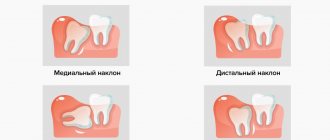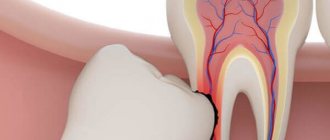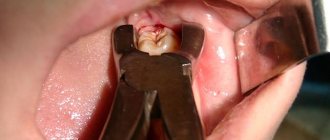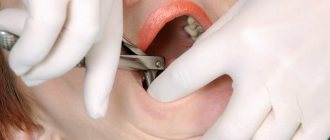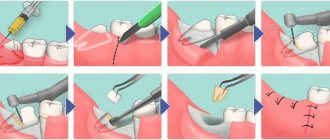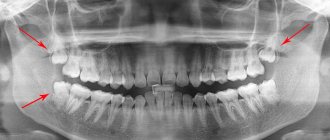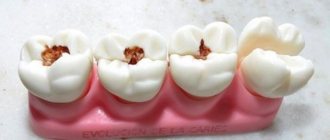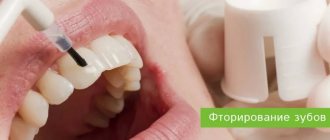Do we need wisdom teeth?
I use the only compound word. In biology there is such a concept as RUDIMENT
- a part of the human body that has lost its function in the process of evolution. The most famous rudiment is the vermiform appendix of the intestine or appendix. So - a large number of doctors and people believe that there is nothing superfluous in the body and wisdom teeth can serve a person at an older age, when the loss of basic teeth occurs and the doctor can use figure eights to install, for example, a bridge.
Unfortunately, in most cases this is impossible and even wrong!
Most people simply do not have room in the jaw for eighth teeth, and Mother Nature begins to mock them (and, naturally, us doctors) in every possible way: painful eruption, irregular shape, incorrect size of the tooth itself, poorly developed root system - all of the above leaves no chance for the correct use of “eights”.
How wisdom teeth are formed
Unlike other teeth, the rudiments of wisdom teeth are formed not during intrauterine development, but at 3–5 years, when the child’s body is preparing to replace milk teeth with permanent dentition. At this age, you can determine the number of future eights (and there can actually be from one to four). But at this age, it is not yet possible to detect any possible developmental pathologies.
It becomes more or less clear a little later, the crown part of the wisdom teeth begins to form. The formation process starts in a child at about 12 years of age, but the development of the root part of the figure eight takes several more years and can continue even after tooth eruption. Considering that the most common age for the appearance of wisdom teeth is 18–25 years, the eruption of eights occurs already in adulthood. It’s not for nothing that I said earlier the phrase “actually from one to four,” since approximately 10–15% have no eights at all. That is why it is normal to consider the number of teeth in an adult to be from 28 to 32. Those are wisdom teeth, right? How unwise they treat us and make puzzles!
Causes
Here local and general causes of tooth impaction are distinguished.
Common ones include an incorrect nutritional system for infants, the presence of systemic diseases in a chronic form, and exhaustion of the body due to infectious diseases.
If we talk about local causes of retention, these are the following options:
- the rudiments of permanent teeth are incorrectly located;
- the temporary teeth began to change belatedly;
- on the path of the tooth, dense teeth in the neighborhood were formed;
- the jaw has changed;
- The roots of baby teeth were not reabsorbed in time;
- milk teeth were removed early.
According to dentists, there are also embryological and anatomical causes. The first include: incorrect rudiments of teeth, their inclination, thick gums through which the tooth is simply not able to cut through, thick walls of the sac that is located around the crown; as a result of improper nutrition, growth-forming factors have decreased.
If we talk about anatomical reasons, then this is heredity or loose submucosal tissue of the gums.
Cutting out wisdom teeth is a real headache
The “birth” of a wisdom tooth in the oral cavity is always painful. The main reasons for the painful effect are thick walls of the dental sac, thickened mucous membrane and reduced growth-forming factors. In addition to the painful process itself, teething can cause many other complications. Which ones? Let's talk about this in a little more detail.
The wisdom tooth sometimes does not erupt completely, crowding the surrounding teeth. This situation usually entails local inflammation and pain.
The time during which a wisdom tooth is cut can be quite long, and inflammation can constantly bother you, manifesting itself as an increased temperature of the whole body and sensitive pain, which sometimes makes it difficult to even just open your mouth! This condition is fraught with inflammation of the tissues surrounding the problematic tooth, right down to the bone, and therefore requires immediate intervention by a qualified dentist.
The first problem with teething eights is caries.
Often, while a wisdom tooth is growing, it is difficult to effectively clean it (due to the location of the wisdom teeth deep in the jaw). This is how caries occurs. Incorrect positioning of wisdom teeth during eruption also increases the risk of tooth decay on the adjacent tooth due to difficulty accessing the spaces between these teeth. If symptoms of caries appear, you must consult a dentist and carry out appropriate treatment. Very often in this case, it is recommended to remove the wisdom tooth, especially if all other teeth are developed normally.
In practice, it happens that a wisdom tooth erupts already... sick, that is, it becomes infected with caries while still in the gum. In such cases, the figure eight should be removed immediately so that the diseased wisdom tooth does not negatively affect the remaining teeth.
The second problem is a cyst
In rare cases, a cyst and tumor may develop in the tissues surrounding an erupting wisdom tooth, which requires immediate surgical intervention by a dental surgeon.
The third problem is malocclusion
If the position of a wisdom tooth is incorrect during eruption, there is a high probability that such a tooth will significantly affect the position of the remaining teeth, which causes a change in the bite. And aesthetic problems arise - the teeth begin to stand crooked in the mouth. And this entails orthodontic treatment, bringing the dentition in order.
The fourth problem is tongue dysfunction
In addition to aesthetic problems, this can also cause functional problems. For example, if a wisdom tooth is displaced towards the vestibule of the oral cavity, serious injury to the mucous membrane of the cheeks, lips or tongue can occur, causing the appearance of erosions and ulcers.
Fifth problem - the wisdom tooth wanted to erupt, but could not erupt
Rarely, a situation occurs when, due to a lack of space in the dentition or in the case of an incorrect inclination of the wisdom tooth itself, an anomaly develops, called a “submerged wisdom tooth.” Such “submerged” teeth are usually removed.
It is possible that the wisdom tooth does not erupt
at all. Despite its absence, such a tooth is dangerous due to its complications. It can damage the roots of neighboring teeth or provoke neuralgic pain. In this case, you need to contact a surgeon and, most likely, the figure eight will have to be removed.
The sixth problem is pericoronitis
At the moment of eruption of the lower (!) wisdom teeth, when only part of the tooth has appeared, acute inflammation and even accumulation of pus in the formed hood between the gum and tooth can occur. This causes a serious disease called pericoronitis (pericoronitis).
The main symptoms of the inflammatory process during pericoronitis are pain and swelling of the gums surrounding the wisdom tooth, bad breath and an unpleasant taste.
If these symptoms appear during the eruption of a wisdom tooth, you should urgently consult a dentist.
The seventh problem of wisdom teeth is periodontitis
When the figure eight erupts quite smoothly, due to its inconvenient location during brushing, the wisdom tooth is not properly cleaned of plaque. Removing tartar and plaque on this tooth in dentistry is also problematic. Because of this, bacteria begin to accumulate around the wisdom tooth, causing inflammation of the gums - periodontitis, which can then develop into osteoperiostitis. In this case, the tooth must be removed.
Kinds
Today, a distinction is made between complete or partial retention.
If we talk about complete, then the tooth remains completely covered with gum, we cannot see it, and it cannot be felt during palpation. It can be covered with a layer of bone or mucous membrane. If the retention is partial, then the crown is slightly exposed, and part of it remains covered with the mucous membrane.
Impacted teeth can be positioned horizontally, vertically, and there are also positions such as buccal-angular or lingual-angular.
You can get a quality consultation on wisdom teeth in your city
I want to check my eights!
Treat or remove eights?
Now regarding orthodontic treatment and wisdom teeth. Believe me, it is very unpleasant for us doctors, as well as for patients, to make radical decisions. But there are good reasons! These are your own stories. Stories of patients who underwent treatment with braces as teenagers, achieved excellent results and...
All the beauty of straight teeth, especially the lower incisors (you just started to enjoy a beautiful smile) - it disappears at 20 and beyond. It is when most of us fully develop these “eights”. Two, three and even four years of therapeutic “torment” to correct crooked teeth, transform them into a beautiful/sweet/courageous smile, as they say, down the drain... Yes, yes - the only option to become the owner of beautiful teeth again is repeated orthodontic treatment. It doesn’t matter whether it’s aligners or braces again, the important thing is that there is a good saying: forewarned is forearmed! No one is immune from mistakes and relapse.
Our body is beautiful and magical in that it almost always adapts and compensates for almost any pathology. Therefore, the “eights” cut through with difficulty and subsequently deform
there are very important teeth in front!
So what do we do with eights?
The moral of this story is this: trust qualified and educated doctors, not kind and humane “neighborly” advice. Be wise. Especially at such crucial moments in life, when wisdom teeth make themselves felt. And in general, I wonder who was the first to call them “wisdom teeth”?
Moreover, an interesting point from medical practice: if you (what if?) decide to remove the eights, it is not a fact that they will be removed for you. The reason is simple - wisdom teeth must be removed exactly according to indications. A normal doctor will never remove a healthy tooth just because you want it.
You have decided to remove your wisdom teeth. How traumatic is this?
If the wisdom tooth has grown normally, its roots are not intertwined, removal usually takes place without any complications. The edges of the tooth socket after extraction are often not even sutured.
What is most important after removing the figure eight is to allow the socket of the just removed wisdom tooth to heal. Quite a big wound.
What is absolutely impossible to do?
You should not rinse vigorously, even with such seemingly beneficial solutions as chamomile or calendula.
What needs to be done.
To get rid of food debris, you need to carefully take water into your mouth and do short oral baths without intensive rinsing. Instead of water, you can use a solution of chlorhexidine, miramistin or analogs specially sold in pharmacies - they disinfect the oral cavity. And so - for at least three days. If this recommendation is neglected, the hole may become inflamed. Then the dentist prescribes treatment with medications, including antibiotics.
What if the roots of an insidious wisdom tooth are intertwined or fused?
Unfortunately, in this case complications cannot be ruled out - soft tissues may be damaged. If an inflamed tooth is removed, in rare cases the neurovascular bundle (!) of the lower jaw is injured. In this case, separate treatment may be required.
Medicines
Using analgesics will eliminate the pain, but its source will remain. Use:
- Anti-inflammatory drugs to reduce fever and swelling (paracetamol, ketorolac, ibuprofen);
- Analgin and local anesthetics reduce tissue sensitivity;
- Antiseptics (miramistin, chlorhexidine) - act on pathogenic microorganisms.
When is it advisable not to remove wisdom teeth?
There are situations when the “seventh” or “sixth” chewing teeth must be removed. And in this situation, a wisdom tooth that has grown correctly may still be useful. It will become one of two supports for the future bridge. However, in this case, a healthy sixth (or fifth) tooth will suffer, because it will have to be treated for an abutment crown.
Now a little about sad things
. 10-15 years will pass, the bridge will “work out” its required operating time. And sometimes it will no longer be possible to insert an implant - the atrophied jaw bone under the bridge will not allow it: in the absence of teeth, any person develops edentulous bone tissue. Thus, on the horizon of life there appear removable jaw dentures and newfangled gels that make them easier to wear.
Now a little about the positive
.
In such situations, you can initially consider dental implantation in specialized
medical centers, where they will help restore bone volume and take control of the dental situation.
Consequences
In the absence of proper treatment, quite serious consequences can occur:
- facial aesthetics are impaired;
- teeth located on the sides shift;
- an odontogenic cyst forms;
- the roots of the teeth in the neighborhood are reabsorbed;
- neighboring teeth erupt incorrectly.
The most common diagnosis is impacted wisdom teeth.
What do we do after removing the eights?
We evaluate the possible damage that figure eights could cause to neighboring teeth. If the adjacent teeth are deformed, then the pathology may spread like a domino effect, and here it is already necessary to carry out systemic orthodontic treatment aimed at correcting the disturbed bite.
The most gentle and aesthetic type of dental correction today is aligners. The site provides a lot of information on aligners, but I would like to mention one undeniable advantage, namely, the patient can see the result of his treatment with aligners without even starting it! How so, you ask? The answer is simple - all future treatment of the patient is calculated using modern computer technology. The example below shows a real clinical case, a patient with crowded teeth caused precisely by the pathological effect of “eights” on neighboring teeth.
Symptoms
Of course, with retention, symptoms arise. Typically, a person notices general malaise, fever, redness, swelling of the gums, partial eruption, and missing teeth. If you feel the gums, pain occurs.
Partial
If the retention is partial, then you can see the top of the tooth above the gum or feel it. It is also visible thanks to the dental probe.
Full
Here the tooth is completely covered by gum. It cannot be felt or seen during an examination or examination of the oral cavity. To detect the rudiments, it is worth conducting an x-ray examination.
Let's see how wisdom teeth led to crowded teeth
And how crowded teeth are eliminated with Star Smile aligners
The video shows how the 3D setup is done. I am commenting on the video, orthodontist Alexander Spesivtsev, clinical director of Star Smile, a doctor with many years of experience in the successful use of aligners in orthodontic practice. To restore straight dentition, the wisdom teeth themselves—the eights—had to be removed. At Star Smile, or rather in the clinics of its partners (more than 70 cities in Russia), any treatment begins with diagnosis and drawing up a virtual setup. The doctor takes photographs of the patient’s face, dentition, as well as x-rays and dental casts. Using special software, the obtained data is processed and a three-dimensional model of the patient’s dental system is obtained. And this already allows you to calculate the trajectory of tooth movement, treatment time, and the required number of sets of aligners. Also, the final result of the treatment will be visualized - the patient will be able to evaluate the aesthetics of the smile after treatment. Patients really like this approach - they can see their future smile, their straight teeth. The forecast of a 3D setup when straightening teeth with aligners comes true in almost 100% of cases. You see, this is completely different from correcting a “blind” bite, as is usually the case with braces. Everything is clear here, without any guesswork or assumptions.
Gevorkyan Oscar Vladimirovich
Candidate of Medical Sciences, Oral and Maxillofacial Surgeon, Central Scientific Research Institute, Scientific Consultant Star Smile “ If you are faced with questions
:
- To remove or not to remove wisdom teeth?
- How dangerous is it to remove wisdom teeth?
- When do wisdom teeth interfere with orthodontic treatment?
- and most importantly, is it possible to avoid the removal of “eights”?
Feel free to contact the doctors at Star Smile, they will help you understand this sometimes complex, but very important life problem for many.
Do not delay the decision in order to avoid possible complications in the future.” Since the Star Smile company is represented in all federal districts, large and medium-sized cities of Russia and interacts with many clinics and orthodontists, we offer you the opportunity to undergo a free consultation with high-quality orthodontists in your city , where you can discuss the problem of wisdom teeth and determine the optimal solution for you. To do this, you need to fill out the form below, a Star Smile medical specialist will contact you and help you by scheduling a consultation at a convenient time or providing your doctor’s contact information.

